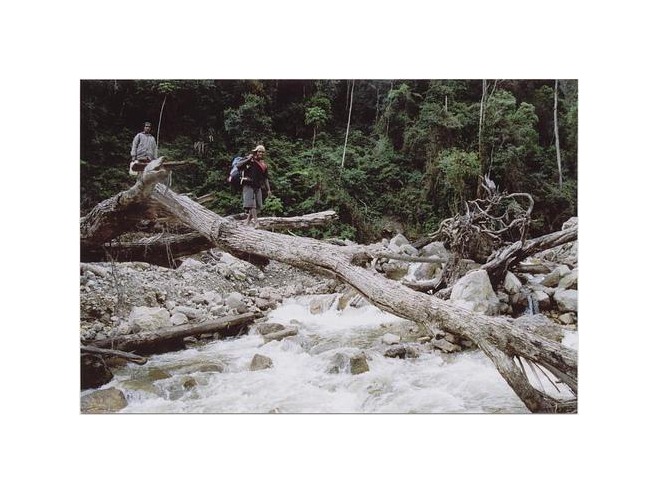Kiroma
Kiroma is the last village of the Baliem Valley‘s Dani people. If you have trekked this far (12 hours from Wamena, with a 10,000 population the largest “town” in the West Papuan interior) then the chances are you are planning to trek onwards into Yali country, most likely at least as far as the main village and ex-missionary outpost there, Angguruk. This page will describe the two possible routes from Kiroma into the Yalimo along with their advantages and disadvantages. See the main West Papua and Baliem Valley pages for all information on actually getting to Kiroma, guides, where to stay in villages, chartering missionary planes, etc.
The route over Gunung Elit
The quickest but most physically demanding and dangerous route. It is through uninhabited territory and heads up a near vertical mountain slope (only trekking and clambering, no special equipment required), leaving you potentially very tired when you arrive at the top. You then cross a plateau and begin the descent which for several hours is literally vertical. You climb down ladders of sticks tied together and tree trunks with steps hacked into them. A wrong move, a wet and rotten ladder rung or simple tiredness could prove quite nasty. This route takes you to the Yali village of Pronggoli from where you can trek on to Angguruk, Kosarek and Mek country if you so desire. There are three basic shelters along the way where it is possible to overnight but it can get very cold up there. The first shelter (three hours trek from Kiroma) is called Mulubaraik. It is not as high up as the others though. From Mulubaraik it is possible to trek to Angguruk in one day if you walk 16 hours very fast without stopping. Most westerners would do it more slowly though and would most likely overnight in Pronggoli or one of the shelters on the way.
The route via Ninia
This route is longer (at least one extra day) but easier than the one described above. “Easier” does not mean “easy” though – this is still New Guinea, an island whose extreme topography kept villages so isolated from one another that 1000 different languages developed, and the terrain is pretty punishing!
From Kiroma you head up over a mountain and down the other side to the village of Moning about six hours away. If you need to cook or sleep on the way (for example if you are coming from somewhere further than Kiroma and it is getting towards evening) there is a place halfway up the mountain with a huge overhanging cliff that protects you from the rain and has straw lain out all over the ground. All locals know this place. It is pictured on this website’s Moning page.
In Moning, Ninia and Sobaham locals (and my Dani porter from Kurima in the Baliem Valley) told me that the people in this area are Yali and speak one of the Yali dialects although the area is not itself considered the Yalimo.
From Moning it is another six or seven hours trek on to Ninia, the largest village in the area with a grass airstrip that receives very irregular missionary flights from Wamena.
From Ninia it is three hours on to the area’s last village, Sobaham. From Sobaham it something like a 14-hour trek across uninhabited territory to the first village of the Yalimo, Waniyok, itself a three hour trek from Angguruk, the biggest village in the Yalimo. There are a couple of shelters you can overnight in if necessary along the way.
Strangely, the area around Ninia, Moning and Sobaham was the least traditional (in terms of dress) that I saw anywhere in the West Papuan Highlands. Although everyone lives in honais (circular thatch huts), everyone wears cheap western dress. Though in the neighbouring Baliem Valley and Yalimo areas most people these days wear modern dress, a few (perhaps 10% in the Yalimo) still wear penis gourds (kotekas) and women’s grass or bark skirts.

Leave a Reply